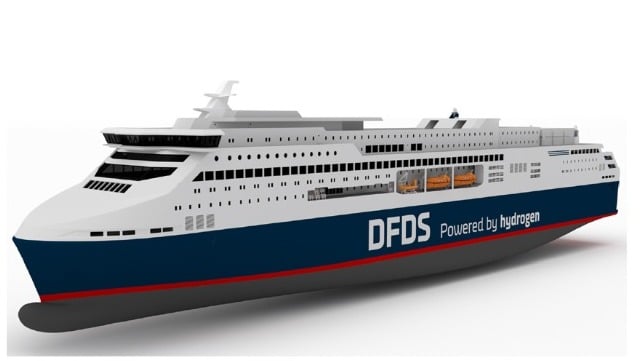Project Aims to Scale-up Hydrogen Fuel Cells to Power Large DFDS Ferry

Plans were unveiled for a large ferry designed to run entirely on electricity produced from hydrogen fuel cells. To achieve the ambitious goals of launching the ferry, which would be the first of its kind in the world, requires scaling-up fuel cells while also developing new technologies to integrate into the local energy system.
The ferry, which has a working name of Europa Seaways and is being designed for DFDS’ Oslo – Frederikshavn – Copenhagen route, will require a hydrogen fuel cell system that can produce up to 23 MW to propel the ferry, approximately four to five times the power of the currently available fuel cells. Powered 100 percent by green hydrogen, the ferry which is being designed to carry 1,800 passengers and 120 trucks or 380 cars, would only emit water.
“The largest fuel cell systems today produce only 1-5 MW, and the development of such large-scale fuel cell installations for an electric ferry is a monumental task,” says Torben Carlsen, CEO of DFDS. “We can only succeed in partnerships with companies that together can muster some of the globe’s finest expertise in design, approval, building, financing, and operation of innovative vessels.”
Participating in the project with DFDS are some of the leading companies in the field, including ABB, Ballard Power Systems Europe, Hexagon Purus, Lloyd’s Register, Knud E. Hansen, Ørsted, and Danish Ship Finance. The partnership has also applied for support from the EU Innovation Fund.
“Together, we expect to learn how to make these fuel types and technologies commercially viable, which is key to a transition of the industry to climate neutrality,” said Torben noting that it is also the goal of DFDS’ climate plan.
The partnership will also investigate how to optimally integrate with the local energy system. To achieve comprehensive environmental results, the objective is to use green hydrogen produced by a projected offshore wind energy-powered electrolyzer plant in the greater Copenhagen area.

that matters most
Get the latest maritime news delivered to your inbox daily.
As there are no ferries of this kind in the world today, the partnership admits that there is a high level of uncertainty involved in the project. However, if it develops as projected, the ferry could be in full operation as early as 2027.
Vessel details
Onboard power production - PEM Fuel cells
Engine power - 23MW
Fuel - Compressed hydrogen
Fuel tank capacity - 44T
Passenger capacity - 1,800
Trailer and car capacity - 2,300 lane meters
Route - Copenhagen - Frederikshavn - Oslo
Roundtrip time - 48 hours
Bunkering interval - 48 hours
CO2e/year emission avoidance - 64,000 Tons
